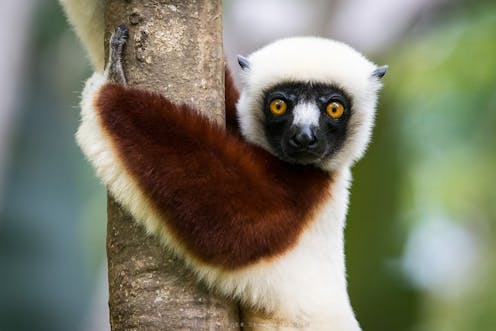Lemur: The Adorable Monster of Madagascar
Lemurs belong to a group called prosimian
primates, defined as all primates that are neither monkeys nor apes. Though
there are many species of lemur, there are very few individuals. Lemurs are
considered the most endangered group of animals on the planet. These primates
are only found in one small area of the Earth. Many species have small and
decreasing numbers.

Size
There are a whopping 105 species of lemur,
and they naturally come in a wide range of sizes. The largest lemur species is the indri. It
grows up to 24 to 35 inches (60 to 90 centimeters) long and weighs 15.5 to 22
lbs. (7 to 10 kilograms). The smallest lemurs are the Madame Berthe’s
mouse lemur, which grows to 3.5 to 4 inches (9 to 11 cm) long, not counting the
tail. The tail adds just 5 inches (13 cm) to its length. These small lemurs
only weigh 1 ounce (30 grams). There once were lemurs that were as big as
gorillas. These are now extinct.
Classification
Kingdom
The Ring-Tailed Lemur belongs to the ANIMAL Kingdom.
(He isn’t like a plant – he cannot create energy from light and minerals.)
The next category is PHYLUM.
The Ring-Tailed Lemur belongs to the CHORDATE Phylum.
(He has a backbone.)
CLASS is the next category.
The Ring-Tailed Lemur belongs to the MAMMAL Class.
(Lemurs feed their babies milk and have fur.)
(Lemurs feed their babies milk and have fur.)
The next category is ORDER.
The Ring-Tailed Lemur belongs to the PRIMATE Order.
(Characteristics of the Primate Order include a thumb separated from other digits and brain structured for higher reliance on sight and eye-hand coordination.)
FAMILY is the next category.
The Ring-Tailed Lemur belongs to the LEMURIDAE Family.
(The Lemuridae Family are those with a smaller brain, a tail, a slightly longer nose, and special dental features.)
The next category is GENUS.
The Ring-Tailed Lemur belongs to the LEMUR Genus.
(The members of the Lemur Genus share characteristics like vocalizations, body shape, and social structures.)
And finally, the SPECIES category. RING-TAILED LEMUR
(This is the grouping of those with the same general genetic information.)
Habitat
Lemurs only live in one place in the world, Madagascar and the nearby Comoro Islands, which are off the coast of Mozambique in Africa. They occupy many different habitats: dry deciduous forests, spiny forests, rain forests, wetlands and mountains.
Diet
Some lemurs are herbivores, which means they do not eat meat. They love fruit, but will also eat flowers, leaves, tree bark and sap. Other lemurs are omnivores and eat a variety of foods that include fruits, nectar, flowers and leaves with a side of insects, spiders and small vertebrates, according to the World Animal Foundation.
Offspring
Mating in the lemur world is a battle of the strongest scent. Males spray their tails with secretions and wave them at each other. The male with the smelliest tail wins dominance.
Once she has mated, the female will have a gestation period of 102 to 170 days, depending on the species. A female can give birth to one to six babies at a time. Smaller species of lemur tend to give birth to more babies, according to the San Diego Zoo.
Baby lemurs are called pups. Many lemur species will cling to the mother’s belly for the first three to four weeks of life and then the pup will ride on her back until it is three or four months old. At three to six months the babies are weaned.
Growing up can take one to three and a half years, depending on the species. This can be a short time when compared to how long lemurs live. Some lemurs can live up to 30 years.

Additional Resources
Live Science: Facts About Lemurs
Click here for infographic


Comments
Post a Comment